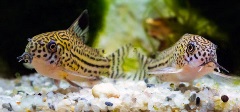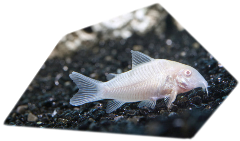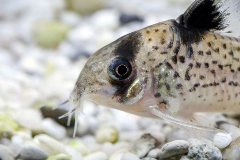| Sep 13, 2023
Corydoras Catfish!
 Sharp-looking, easy to care for, and friendly, Cory cats bring both aesthetic beauty and functional benefits to the aquatic ecosystem. Corydoras catfish, also known as the "armored" catfish - part of a genus of over 165 Corydora species that has even hundreds more still to be classified - can grow up to 1-4" and live up to 5-20 years depending on care, any changes in the tank, and overall conditions and maintenance.
Sharp-looking, easy to care for, and friendly, Cory cats bring both aesthetic beauty and functional benefits to the aquatic ecosystem. Corydoras catfish, also known as the "armored" catfish - part of a genus of over 165 Corydora species that has even hundreds more still to be classified - can grow up to 1-4" and live up to 5-20 years depending on care, any changes in the tank, and overall conditions and maintenance.
The name comes from the greek words "kory" for "helmet" and "doras" for "skin," and the armor on their bodies is made of bony plates that run along its entire body!
 These bottom-dwellers will live happily with and will not typically be inclined to disrupt or bother other fish. Although this makes them more likely to be bullied by more aggressive fish species due to it’s peaceful, reclusive nature and lack of desire for confrontation. Provide them with a nice, shaded hiding place such as a cave or type of driftwood structure. Plants are a wonderful option, too! Java fern and java moss, hornwort, hairgrass, or amazon sword plants can make good and visually pleasing options!
These bottom-dwellers will live happily with and will not typically be inclined to disrupt or bother other fish. Although this makes them more likely to be bullied by more aggressive fish species due to it’s peaceful, reclusive nature and lack of desire for confrontation. Provide them with a nice, shaded hiding place such as a cave or type of driftwood structure. Plants are a wonderful option, too! Java fern and java moss, hornwort, hairgrass, or amazon sword plants can make good and visually pleasing options!
 As bottom-feeders, Cory cats have adapted with horizontal pectoral fins for resting on the substrate/bottom and three pairs of barbels for rooting out food in the substrate. At least 2 inches of substrate (softer and not jagged or rough if possible to prevent potential harm) will make them comfy since they spend most of their time at the bottom of the tank.
As bottom-feeders, Cory cats have adapted with horizontal pectoral fins for resting on the substrate/bottom and three pairs of barbels for rooting out food in the substrate. At least 2 inches of substrate (softer and not jagged or rough if possible to prevent potential harm) will make them comfy since they spend most of their time at the bottom of the tank.
While fairly tolerant to varying pH and hardness levels, one will need to keep an eye on the ammonia and nitrite levels as catfish are more prone to stress or health issues from this, especially when introducing them into a new tank. Be sure additions to the tank are made after water testing and when the tank is mature with no measurable amounts of nitrite or ammonia in the water. They tend to prefer softer, acidic water and will make frequent trips to the surface for a gulp of air as they are able to absorb oxygen through the walls of the intestine. Be certain your tank is covered since Cory catfish tend to have a habit of leaping out from the surface after coming up for a gulp of air!

Cory Cats take to aquarium life quite well and will readily feed on prepared foods from bottom feeder or algae tabs / wafers to flakes or pellets, but regular feedings of live foods like Blackworms, Bloodworms, Daphnia and Brine shrimp are highly relished.
Since they are pretty social, these fish would love to school with their own species or similar fish in 4-6 or more fish together. Use at least a 20 gallon tank for a small school, then adding 2-4 gallons per additional fish; some possible tankmates may include other catfish, certain plecos, mollies, het. harlequin or flame rasbora, guppies, platies, or swordtails. They're also more fun to observe when there are multiple Corydoras in your tank since, if they’re schooling in groups of five or more, they’ll provide you with a synchronized water dance that is truly amazing!
 Active, pleasant and peaceful, lively, and fairly hardy, these catfish can be good for beginners or aquarists of all levels. Plus, they come in varieties of patterns, have adorable barbel "whiskers," and big, lovable eyes! If you’re someone who enjoys a low-stress aquarium experience, this is a great fish for you. Now, Assorted Cory Catfish are just $3.99 now until 10/16/23 at Uncle Bill's with your Extra Value Card!
Active, pleasant and peaceful, lively, and fairly hardy, these catfish can be good for beginners or aquarists of all levels. Plus, they come in varieties of patterns, have adorable barbel "whiskers," and big, lovable eyes! If you’re someone who enjoys a low-stress aquarium experience, this is a great fish for you. Now, Assorted Cory Catfish are just $3.99 now until 10/16/23 at Uncle Bill's with your Extra Value Card!